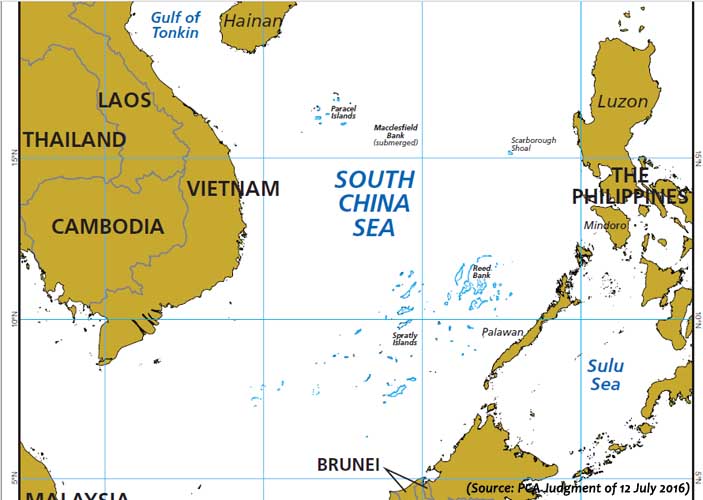On January 22, 2013 the Philippines had instituted an arbitral proceeding against China in the Permanent Court of Arbitration (PCA) under Annex VII of the United Nations Conventions on the Laws of the Seas (UNCLOS) as case number 2013-19. After over three years of deliberation the Court awarded their judgement on July 12, 2016 in favour of the Philippines, which China refused to comply. Since the UNCLOS has no jurisdiction over land territories, the judgement did not comment on the sovereignty over the Spratly Iislands or the Scarborough Shoal. Although UNCLOS has jurisdiction over delimitation of maritime boundaries, the PCA could not comment on this aspect either. This is primarily because China had made a declaration in 2006 to exclude maritime boundary delimitation from dispute settlement, which is permitted under the UNCLOS (Declaration of Statements, Ocean & Laws of the Sea, UN, 29 October 2013). So what was the judgment by the PCA about?
What was the Dispute?
Due to the aforesaid limitations, the disputes that the Philippines had placed before the Tribunal fell broadly within three categories. First, the Philippines had asked the Tribunal to resolve the dispute concerning the source of maritime rights in the South China Sea (SCS), to preclude China from laying claims based on historic rights within the nine-dash lines. Second, the Philippines had asked the Tribunal to resolve the entitlements to maritime zones generated by Scarborough Shoal and relevant Spratly Islands. A submerged banks or a low-tide elevation that is incapable of sustaining human habitation or economic life are not entitled to Exclusive Economic Zone (EEZ) of 200 nautical mines. Third, the Philippines has asked the Tribunal to resolve the lawfulness of China’s actions in the SCS. China had been interfering with the exercise of the Philippines’ rights on fishing, oil exploration, navigation, and the construction of artificial islands and installations; actively supporting Chinese fishermen using harmful fishing methods; and inflicting severe harm on the marine environment by constructing artificial islands and engaging in extensive land reclamation at seven reefs in the Spratly Islands (PCA Award, The SCS Arbitration, 12 July 2016, p2-3).
Judgement of the PCA
The judgement of PCA is unique in a way that it did not restrict itself to addressing the dispute between the Philippines and China but also implicitly addressed the larger dispute of the SCS and legality of Chinese assertions. Since China had objected to the jurisdiction, the Tribunal also deliberated on the issue separately and found that it had jurisdiction over disputes in the SCS. The PCA made four landmark observations:-
Historic Rights claimed by China within the ‘Nine-Dash Line’: The Tribunal ruled that China’s claims to historic rights were incompatible with the EEZ provided for in the UNCLOS. Although navigators and fishermen of China and other States had historically made use of the islands in the SCS, there was no evidence that China had historically exercised exclusive control over the waters or their resources. The Tribunal thus concluded that there was no legal basis for China to claim historic rights to resources within the ‘nine-dash line’ (PCA Press Release, The SCS Arbitration, 12 July 2016, p2) and (PCA Award, The SCS Arbitration, 12 July 2016, p117).
Status of Features: The Tribunal next considered entitlements to maritime areas and the status of the features. The Tribunal studied hydrographic data, navigational publications and satellite imagery to evaluate of whether reefs claimed by China are above the high tide mark as only those features that are above water at high tide mark are entitled to 12 nautical mile territorial sea (TS), EEZ of 200 nautical miles and a continental shelf (CS). In addition, these features should be able to sustain a stable community of people or economic activity in its natural condition. It was found that historically, Spratly Islands were small groups of fishermen which is considered as transient use does not constitute inhabitation by a stable community and none of the Spratly Islands is capable of generating extended maritime zones (TS, EEZ or CS) (PCA Award, The SCS Arbitration, 12 July 2016, p260).
Lawfulness of Chinese Actions: Having found that certain areas are within the EEZ of the Philippines, the Tribunal found that China had violated the Philippines’ sovereign rights in its EEZ. Besides, fishermen from the Philippines (like those from China) had traditional fishing rights at Scarborough Shoal and that China had interfered with these rights by restricting access. Additionally, Chinese law enforcement vessels had unlawfully created a serious risk of collision when they physically obstructed Philippine vessels (PCA Press Release, The SCS Arbitration, 12 July 2016, p2).
Harm to Marine Environment: The Tribunal had also delved into the effect on marine environment due to large-scale land reclamation and construction of artificial islands at seven features in the Spratly Islands. It emerged that severe damaged was caused to the coral reef environment, the fragile ecosystems and the habitat of endangered species. The Chinese authorities had not taken any measures to check such activities (PCA Press Release, The SCS Arbitration, 12 July 2016, p2) and (PCA Award, The SCS Arbitration, 12 July 2016, p319-436).
Militarisation of South China Sea (SCS)
In order to achieve an effective Anti-Access-Area-Denial (A2AD) in SCS, China has adopted three pronged approach – develop Spratly to deny access to southern approaches of the SCS; develop Paracel islands for defence in depth and seal the eastern accesses (see map above). The three islands of Spratly – Fiery Cross, Mischief and Subi Reef are believed to have robust air-defence with HQ-9 missiles and CIWS guns. In addition, they are capable of launching reconnaissance and fighters. In effect the southern approaches of SCS is almost sealed. Woody Island in the Paracel group provides China the required defence in depth. The chink in the A2AD are the eastern approaches to the SCS. Development of Scarborough Island would have solved the puzzle. However, a timely verdict by the PCA has forced China to stop further developments in Scarborough. Thus China’s A2AD in the Taiwan – Philippines gap remains ineffective.
International Pressure
The Chairperson’s statement released by ASEAN post 12th East Asia Summit held on 14 November, 2017 confirms that the earlier adoption of a framework by the members in August 2017 will facilitate in arriving at an effective Code of Conduct (COC) for the SCS (Chairman’s Statement 12th EAS, 14 November 2018). The concept of COC first emerged in the 1990s but has been hanging fire due to its legally binding provisions, China was reluctant to accede. Instead, China agreed on the Declaration on the Conduct of Parties in the South China Sea (DOC) in 2002 as it was legally non-binding and could be flouted. In the intervening period between 2002 and the PCA judgement, China managed to alter the strategic map of SCS irreversibly.
On June 18, 2018 the US National Defence Authorisation Act (NDAA) FY 2018-19 prohibited China from participating in the Rim of Pacific (RIMPAC) naval exercises. Section 1262 states that the pace and militarisation China in the SCS is destabilising to the security of United States allies and partners and threatening United States core interests. The Act has also imposed three conditions for re-induction into the exercises: ceasing all land reclamation activities in the SCS; removing all weapons from its land reclamation sites; and, establishing a consistent four-year track record of taking actions toward stabilising the region. However, there is no condition in the NDAA FY 2018-19 for withdrawal of China from the reclaimed islands (US NDAA FY 19, Art 1259, p 1062).
The G- Charlevoix Summit communiqué held in June 2018 at Quebec, Canada, too raised concerns on the situation in the East and SCS and reiterated strong opposition to any unilateral actions that could escalate tensions and undermines regional stability and international rule-based order. They also registered their opposition to militarisation of the disputed features. Similar views were expressed earlier in the ministerial communiqué of the G-7 group’s Foreign Ministers in April 2018 (The Charlevoix G-7 Summit Communique 9 June 2018, Para 19). The ministerial communiqué had called for implementation of DOC in its entirety. They also recorded their support for the PCA judgment and declared it as a legal basis for resolution of resolving dispute of the SCS. Other powers like India, Japan and Australia besides many other have supported unimpeded commerce, freedom of navigation and overflights and settlement of disputes in SCS through peaceful means. However, China has not paid much heed to the evolving international opinion against China’s muscular policies in the SCS. There is a need for a concerted effort to have a coordinated and unified response against China’s violation of international norms (The Charlevoix G-7 Foreign Ministers Communique 23 June 2018, Para 9).
Concluding Remarks
Chinese ambitions for hegemony is evident from many a unilateral actions in the SCS. But in the recent past China has faced active criticism from all quarters, which has affected its international prestige. It has also attracted a countervailing great- power alliance/ partnership between Australia, India, Japan and US under the rubric of Quad which is yet to fructify in a substantive way. The judgement of PCA has further de-legitimised China’s hostile actions in the SCS. In this backdrop, China should be continually pressured to adhere to international norms as also to move forward on concluding COC. International pressure has to be sustained on China tills it plays by the rules.
Image Source: (Source: PCA Judgment of 12 July 2016)












Post new comment